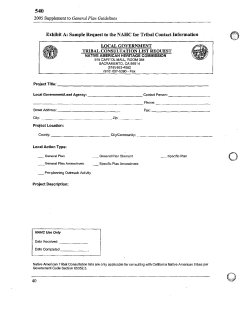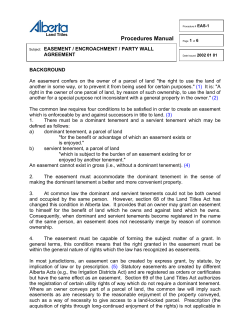
Appraisal of Temporary and Permanent Easements-GA
APPRAISAL OF TEMPORARY AND PERMANENT EASEMENTS REV 04/28/15 Troy Byers – State ROW Administrator (GDOT) REV EASEMENTS Before we start off appraising and valuing Easements: -Define the easement to be appraised -Describe the easement to be appraised - Understand the purpose of the easement to be appraised - Know the duration of the easement WHAT IS AN EASEMENT? *an interest in land owned by another that entitles its holder to a specific limited use or enjoyment *an area of land covered by an easement * Merriam-Webster WHAT IS AN EASEMENT? *a legal right to use another’s land for a specific limited purpose. In other words, when someone is granted an easement, he/she is granted the legal right to use the property, but the legal title to the land itself remains with the owner of the land. * real-estate-law.freeadvise.com TYPES OF EASEMENT S: Easement Appurtenant *said to run with the land, part of the formal ownership of the land. This easement would typically show up in a new land owners title search. ( i.e. driveway, ingress/egress through shopping center, DOT permanent construction easement, etc.) * real-estate-law.freeadvise.com TYPES OF EASEMENTS: Easement in Gross *a personal easement that does not transfer with the property A new owner would not have the right and easement through the property. This easement typically would not show up in a new owners title search. * real-estate-law.freeadvise.com TYPICAL DOT EASEMENTS: “Temporary” Easements “Permanent” Easements TYPICAL DOT EASEMENTS: “Temporary” Easements: -for the construction of _______. (i.e. slopes, ditching, driveway, fencing, etc.) -for the demolition/removal of _______. (i.e. house, barn, building, billboard, etc.) TYPICAL DOT EASEMENTS “Permanent ” Easements: -for the construction and “maintenance” of _______. (i.e. slopes, utilities, berm ditch, etc.) DESCRIBING AN EASEMENT What do you need to describe an Easement? -A good legal description -Preferably plat/or for some of us, “good” ROW plans with data tables -Preferably const. plans or cross sections UNDERSTAND THE PURPOSE OF EASEMENT “Temporary” for the Construction of ditching, slopes, fencing, driveway, etc. “Permanent” for the Construction and Maintenance of ditching, slopes, sidewalks, sediment basin, etc. ESTABLISH THE DURATION OF THE EASEMENT May expire upon completion of construction of the project OR final acceptance of the construction of the project May expire within _____ (certain) number of years May run with title to the land in perpetuity VALUATION OF AN EASEMENT Finally after you have: -Defined the Easement -Described the Easement -Understand the purpose of the Easement -Determine the duration of the Easement you can then begin the market analysis in determining the value of the Easement VALUATION OF AN EASEMENT Temporary Easements - May be compensable - May be non-compensable (driveway, fence, etc.) Permanent Easements - Compensable VALUATION OF TEMPORARY EASEMENTS “Temporary” Construction Easements (excluding non-compensable) involve the short-term rental of the land while the proposed construction takes place. The appraiser’s market research would reveal typical ground rental rates for the underlying land. For instance, an appraiser may determine a ground rental rate of 10% to 13% based on what investors are willing to pay in the market area being examined. VALUATION OF A TEMPORARY EASEMENT For example, an appraiser may calculate the value of a “Temporary Construction Easement for construction of slopes” at $29,160 (5,400 SF X $18.00/SF X 10% X 3 Years = $29,160). In this situation, the appraiser selected a rental rate of 10% based on market ground rent data and a three year holding period based on the projected project construction timeline. VALUATION OF A TEMPORARY EASEMENT Another example, an appraiser may calculate the value of a “Temporary Demolition Easement” at $750 (1,500 SF X $5.00/SF X 10% X 12 mos.) In this situation, the appraiser selected a rental rate of 10% based on market conditions and a one year holding period. (Structures located within or partially within the acquisition area will be removed prior to certification of the right of way and this easement will have a much shorter holding period than most others.) VALUATION OF TEMPORARY EASEMENTS Temporary Easements In Summary (when compensable) -value is typically based on short term rental rates -rental rates are typically derived from ground lease market data VALUATION OF PERMANENT EASEMENTS Permanent Easements -value is typically based on a percentage of a fee owner’s bundle of rights as they are encumbered by the easement VALUATION OF A PERMANENT EASEMENT Generally more “minor to moderate” impact “permanent” easements for construction and maintenance of slopes, drainage, underground utilities, etc. may be valued up to 50% of the fee value. This is based on the view of “Balanced Use” by both the owner and easement holder. VALUATION OF A PERMANENT EASEMENT For example, an appraiser may calculate the value of a “Permanent Easement for the Construction and Maintenance of Slopes” at $32,500 (6,500 SF X $10.00/SF X 50% = $32,500). In this situation, an appraiser has determined that the easement to be acquired represents a “balanced use” by both the property owner and the easement holder and a factor of 50% of fee value was utilized in this value calculation. VALUATION OF A PERMANENT EASEMENT “Permanent” Easements that will be utilized for uses that will “more significantly” impact a property are typically valued at higher rates and typically over 50% of the fee value as more property rights are encumbered. VALUATION OF A PERMANENT EASEMENT For example, an appraiser may calculate the value of a “Permanent Easement for the Construction and Maintenance of Drainage” at $56,250 (15,000 SF X $5.00/SF X 75%). In this situation, the appraiser has determined that the easement to be acquired represents a major future surface use of the property and a factor of 75% of fee value was utilized for this more significant impact. VALUATION OF PERMANENT EASEMENTS Permanent Easements in Summary -value is typically based on a percentage of a fee owner’s bundle of rights as they are encumbered by the easement IN SUMMARY Before we start off appraising and valuing DOT Easements: - Define the easement to be appraised first - Describe the easement to be appraised - Understand the full purpose of the easement to be appraised (good plans/cross sections/data tables) - Know the duration of the easement QUESTIONS/COMMENTS
© Copyright 2025









